| |
|
Xiamen Oil Paintings, Wholesale Direct!
|
|
100% hand painted, 100% cotton canvas, 100% money back if not satisfaction. |
|
|
|
|
ART WORKS INDEX
A
B
C
D
E
F
G
H
I
J
K
L
M
N
O
P
Q
R
S
T
U
V
W
X
Y
Z
|
|
ARTISTS INDEX
A
B
C
D
E
F
G
H
I
J
K
L
M
N
O
P
Q
R
S
T
U
V
W
X
Y
Z
|
|
|
|
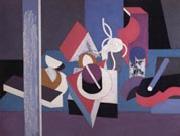 |
Patrick Henry Bruce
|
|
American Cubist Painter, 1881-1936
was an American cubist painter. A descendant of Patrick Henry, Bruce was born in Campbell County, Virginia, the second of four children. His family had once owned a huge plantation, Berry Hill, worked by over 3,000 slaves. Berry Hill is now a resort & conference center outside South Boston, Virginia and is now a National Historic Landmark. Berry Hill Estate originally was part of a 105,000-acre (420 km2) tract granted by the English Crown in 1728 to William Byrd II. The Civil War left the Bruce's wealth greatly diminished. Bruce began taking evening classes at the Art Club of Richmond in 1898, while working in a real estate office during the daytime. His earliest known extant painting dates from 1900. In 1902 he moved to New York, where he studied with William Merritt Chase, Robert Henri, and Kenneth Hayes Miller. By February 1904 he was in Paris, where he would live until 1933. Although his evolution toward a modernist style was gradual, his works of 1908 reveal the influence of Renoir and C??zanne, and in that year he was among the first to enroll in Matisse's school. Bruce exhibited regularly in the Salon d'Automne, and met many of the leading artists of the early twentieth century avant garde.
|
|
|
|
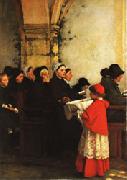 |
Pascal Dagnan-Bouveret
|
|
(January 7, 1852 - July 3, 1929), was one of the leading French artists of the academic school. He was born in Paris, the son of a tailor, and was raised by his grandfather after his father emigrated to Brazil. Later he added his grandfatheres name, Bouveret, to his own.
From 1869, he studied at the Ecole des Beaux-Arts under Alexandre Cabanel and Jean-Leon Gerôme. In 1873, he opened his own studio with a fellow student Gustave-Claude-Etienne Courtois. From 1875, he exhibited at the Salon, where in 1880 he won the first-class medal for the painting An Accident, and a medal of honour in 1885 for Horses at the Watering Trough.
From the 1880s, Dagnan-Bouveret along with Gustave Courtois, maintained a studio in Neuilly-sur-Seine, a fashionable suburb of Paris. By that time he was recognized as a leading modern artist known for his peasant scenes, but also for his mystical-religious compositions. His large-scale painting The Last Supper was exhibited at the Salon de Champ-de-Mars in 1896.[1] He also painted portraits for wealthy clients including the British collector George McCulloch. He was one of the first to use the then new medium of photography to bring greater realism to his paintings.
In 1891, he was made an Officer of the Legion of Honour; in 1900 he became a member of the Institut de France.
|
|
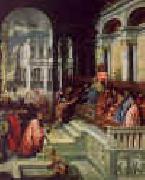 |
Paris Bordone
|
|
Italian
1500-1571
Italian painter and draughtsman. He is best known for his strikingly beautiful depictions of women, both in portraits and in cabinet paintings. He also excelled in rendering monumental architectural settings for narrative, both religious and secular, possibly initiating a genre that would find great currency during the mid-16th century, especially in Venice, France and the Netherlands. His favoured media were oil and fresco, the latter being used on both interiors and faades. Although he was not generally sought after by Venetian patrons during his career, as his art was eclipsed by that of Titian, Paolo Veronese and Jacopo Tintoretto, Bordone was regarded in the mid-16th century as an accomplished artist (Pino; Sansovino). He worked for the moneyed lite of northern Italy and Bavaria, for the royalty of France and Poland, and had works commissioned to be sent to Spain and to Flanders. Despite knowledge of the important patrons for whom he worked, the chronology of Bordones oeuvre is by no means clear. Dating on stylistic grounds is confounded by the diverse sources on which he drew, ranging from the Emilian, Lombard and Venetian to the French and northern European, depending on the patron. Due to the ease with which prints circulated during Bordones career, it is difficult to ascertain whether influences were derived at first hand or from printed images. Such difficulties in assigning dates are further exacerbated by his use of the same figure study for numerous paintings evidently executed decades apart. Reliance on the testimony of Vasari, who interviewed Bordone in 1566, in conjunction with the extant documents, the few signed and dated paintings and, to a lesser extent, period fashion provides only a rough outline of his activity. Due to the lack of agreement among scholars regarding chronology, the following account is based mainly on the documentary evidence.
|
|
|
|
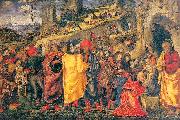 |
Parentino, Bernardo
|
|
Italian Painter, 1437-1531
was an Italian painter of the Renaissance period, active mainly in Padua. Born in Parenzo, then a Venetian town in Istria and died in Vicenza. He was influenced, if not a pupil, of the painter Andrea Mantegna. He became an Augustinian monk under name of Lorenzo. He painted Scenes of the life of San Benedetto for the cloister of Santa Giustina at Padua, and a Nativity once at the Accademia in Venice. He painted a nightmarish Temptation of St. Anthony Abbot found at the Doria Pamphilj Gallery. An Adoration of the Magi
|
|
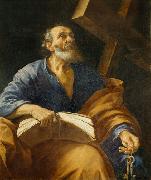 |
Paolo Emilio Besenzi
|
|
(1608-1656) was an Italian painter of the 17th century, born and active in Reggio. He trained with Francesco Albani. Friend and companion of Lionello Spada, he painted for the church of San Pietro. He was also known as sculptor and architect.
|
|
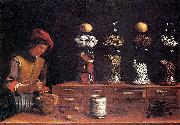 |
Paolo Antonio Barbieri
|
|
(1603-1649) was an Italian painter who was the brother of Guercino. He was born at Cento, a village near Bologna. The subjects of his pictures are flowers, fruit, and game, but he particularly excelled in painting fish
|
|
|
|
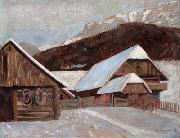 |
Otto Barth
|
|
(18 June 1891 - 3 May 1963) was a highly decorated Generalmajor in the Wehrmacht during World War II who commanded the 30. Infanterie-Division. He was also a recipient of the Knight's Cross of the Iron Cross. The Knight's Cross of the Iron Cross was awarded to recognise extreme battlefield bravery or successful military leadership. Otto Barth was captured by Soviet troops following the fall of the Courland Pocket in 1945. He was held until 1955.
|
|
|
|
|
|
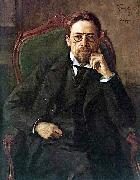 |
Osip Braz
|
|
painted Portrait of Anton Pavlovich Chekhov in 1898
|
|
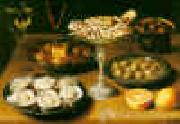 |
Osias Beert
|
|
1580-1624
Flemish
Osias Beert Galleries
Flemish painter. In 1596 he went to study with Andries van Baseroo and in 1602 became a master in the Antwerp Guild of St Luke; these two dates suggest his probable date of birth. Beert married Marguerite Ykens on 8 January 1606. Contemporary documents describe him as a cork merchant. The esteem enjoyed by Beert is indicated by the large number of pupils he had, including, in 1610, Frans van der Borch; in 1615, Frans Ykens; in 1616, Paulus Pontius; and, in 1618, Jan Willemssen. Beerts son, Osias Beert the younger (1622-78), was also a painter and became a master in 1645.
|
|
|
|
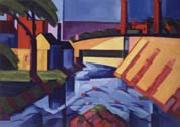 |
Oscar Bluemner
|
|
German-born American Painter, 1867-1938,was a German-born American Modernist painter. He was born in Hanover, Germany. He moved to Chicago in 1893 where he freelanced as a draftsman. He relocated to New York in 1901. In 1910 he met Alfred Stieglitz, who introduced him to the artistic innovations of the European and American avant-garde. Then in 1915 Stieglitz gave him a solo exhibition at his gallery, 291.
|
|
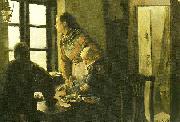 |
oscar bjorck
|
|
född 15 januari 1860 i Stockholm, död av en hjärtattack i sitt hem klockan 03.00 den 5 december 1929, var en svensk konstnär och professor vid Konsthögskolan 1898-1925, och från 1918 även vice preses.
Åren 1877-1882 var han elev till Edvard Pers??us vid konstakademins principskola och målade bland annat prisämnena Loke fängslas af asarne (1880), Gustaf Vasa inför kung Hans (1881) och Den förlorade sonens återkomst (1882, belönad med kungliga medaljen). 1883 fick Björck akademiskt resestipendium och vistades vintern 1883?C84 i Paris. Vintern 1884?C85 reste Björck till M??nchen, målade några porträtt, bland annat ett i helfigur av sin hustru. Våren 1885 flyttade han till Venezia och på hösten till Rom. Där målade han den stora modelltavlan Susanna (Göteborgs museum) och Romerska smeder (galleriet i Washington, en skiss till samma tavla finns i Göteborgs museum). 1887 målades i Venezia Veneziansk saluhall (nationalmuseum), Lördagsmässa i Markuskyrkan och andra tavlor.
Efter en sommarvistelse på Skagen, där han förut tillbringat två somrar, 1882 och 1884, bosatte sig Björck 1888 i Stockholm. Han har sedan huvudsakligast målat porträtt. Bland dessa kan nämnas flera av konung Oscar (bland dem ett på Skokloster, ett i helfigur på Drottningholm, ett med krona och mantel, på Stockholms slott, ett som övergick i tyske kejsarens ägo), prins Eugen vid staffliet (nationalmuseum, 1895), kronprins Gustaf (Stockholms slott, 1900), konstnärens hustru (helfigur, 1891, Göteborgs museum) och friherre Nordenfalk (konstakademien, 1892). Dessutom skapade han några landskap, ett par genrebilder och olika dekorativa målningar.
Från 1889 var han ledamot vid konstakademin och lärare vid Konsthögskolan. 1898 blev han professor.
Björck var kommissarie för konstavdelningen vid Stockholmsutställningen 1897 och vid Baltiska utställningen 1914 samt för den svenska utställningen i London 1924.
|
|
|
|
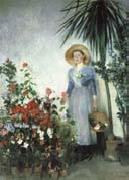 |
Olga Boznanska
|
|
Krakow 1865-1940 Paris,Polish painter. She took drawing lessons at home from the age of nine and began regular studies in 1883 under the portrait painter Kazimierz Pochwalski (1855-1940). She continued her training in 1884-5 at the Adam Baraniecki School of Art, the only school in Krakew accessible to women at that time. She went to Munich for further study, working in the studio of Carl Kricheldorf (b 1863) in 1886-7, and in that of Wilhelm Derr (1857-1900) in 1888. In 1889 she participated in the Internationale Kunstausstellung in Munich and opened her own studio, which over the next decade became a meeting-place for students. In 1895 she ran a private school of painting founded by Professor Theodor Humml (1864-1939).
|
|
|
|
|
|
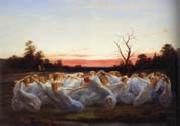 |
Nils Blommer
|
|
1816 - 1853,was a Swedish painter. Starting his career as an apprentice in Lund he experimented with painting portraits from the age of 20. He achieved some successes and in 1839 he had saved up enough money to move to Stockholm. There he took the name Blomm??r and enrolled in the Fria konsternas akademi. After winning the academy's prize several times he got a stipend in 1847 to travel abroad. He spent time in Paris but later moved to Italy, where he married his wife Edla Gustafva Jansson, also a painter, in November 1852. A few months later he caught a fatal chest disease
|
|
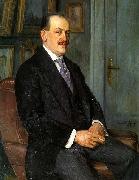 |
Nikolay Bogdanov-Belsky
|
|
(Russian 1868-1945) was a Russian painter.
Bogdanov-Belsky was born in the village of Shitiki in Smolensk Governorate in 1868. He studied art at the Semyon Rachinsky fine art school, icon-painting at the Troitse-Sergiyeva Lavra in 1883, modern painting at the Moscow School of Painting, Sculpture and Architecture in 1884 to 1889, and at the Imperial Academy of Arts in St. Petersburg from 1894 to 1895. He worked and studied in private studios in Paris in the late 1890s.
Bogdanov-Belsky was active in St. Petersburg. After 1921, he worked exclusively in Riga, Latvia. He became a member of several prominent societies in including the Peredvizhniki from 1895, and the Arkhip Kuindzhi Society from 1909 (of which he was a founding member and chairman from 1913 to 1918).
Bogdanov-Belsky painted mostly genre paintings, especially of the education of peasant children, portraits, and impressionistic landscapes studies. He became pedagogue and academician in 1903. He was an active Member of the Academy of Arts in 1914. Bogdanov-Belsky died in 1945 in Berlin.
He was a member of the Russian Fraternitas Arctica in Riga.
|
|
|
|
|
|
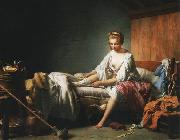 |
Nicolas Bernard Lepicie
|
|
was a French painter (16 June 1735 - 15 September 1784), the son of two reputed engravers at the time, Francois-Bernard and Renee-Elisabeth, was introduced to the artistic and cultural environment by his parents.
Nicolas-Bernard studied with reputed artists of the century including Carle Vanloo. In 1769 he was accepted to the Royal Academy of Painting and Sculpture in Paris. Three years later, in 1770, he became an assistant professor and, in 1777, a professor. Important names such as Carle Vernet, Jean-Frederic Schall, Jean-Antoine-Theodore Giroust, Jean-Joseph Taillasson, Henri-Pierre Danloux, Jean-Baptiste Regnault and Nicolas-Antoine.
|
|
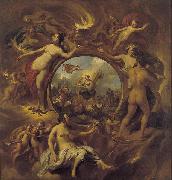 |
Nicolaes Pietersz. Berchem
|
|
(1 October 1620 - 18 February 1683) was a highly esteemed and prolific Dutch Golden Age painter of pastoral landscapes, populated with mythological or biblical figures, but also of a number of allegories and genre pieces.
Born in Haarlem, he received instruction from his father Pieter Claesz, and from the painters Jan van Goyen, Pieter de Grebber, Jan Baptist Weenix, Jan Wils and Claes Cornelisz. Moeyaert.According to Houbraken, Carel de Moor told him that Berchem got his name from two words "Berg hem" for "Save him!", an expression used by his fellows in Van Goyen's workshop whenever his father chased him there with the intent to beat him. No trip or Grand Tour by Berchem was documented by Houbraken though he mentioned another story about the "Berg hem!" nickname which came from Berchem's conscription as a sailor; the man in charge of impressment knew him and sent him ashore with the words "Save him!".Today his name is assumed to come from his father's hometown of Berchem, Antwerp. According to the RKD he traveled to Italy with Jan Baptist Weenix, whom he called his cousin, in 1642-5. Works by him are signed both as "CBerghem" and "Berchem".
|
|
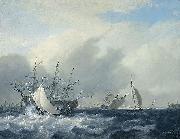 |
Nicolaas Baur
|
|
who was born at Harlingen in 1767, was the son of Hendricus Antonius Baur, a portrait painter (born 1736, died 1817). He painted landscapes and views of cities, and many houses in Holland are embellished by his works. He also painted moonlight and winter scenes; and was particularly successful in marine subjects. He is considered one of the best of the later Dutch marine painters. He died at Harlingen in 1820.
|
|
|
|
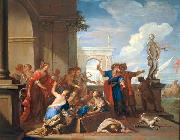 |
Niccolo Bambini
|
|
(1651-1736) was an Italian painter of the late-Renaissance and early-Baroque periods.
He was born in Venice, and first studied under Giulio Mazzoni at Venice; but afterwards went to Rome, where he became a pupil of Carlo Maratti. He painted for the church of San Stefano soon after his return from Rome. He died in Venice. He had two sons who were painters, Giovanni and Stefano.
|
|
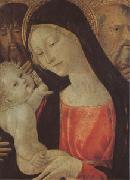 |
Neroccio di Bartolomeo
|
|
1447 - 1500
was an Italian painter and sculptor of the early-Renaissance or Quattrocento period in Siena. He was a student of Vecchietta, and then he shared a workshop with Francesco di Giorgio from 1468. He painted Scenes from the life of St Benedict, now in the Uffizi, probably in collaboration with di Giorgio, and a Madonna and Child between Saint Jerome and Saint Bernard, which is in the Pinacoteca of Siena. In 1472 he painted an Assumption for the abbey of Monte Oliveto Maggiore, and in 1475 he created a statue of Saint Catherine of Siena for the Sienese church dedicated to her. He separated from di Giorgio in 1475. In 1483, he designed the Hellespontine Sybil for the mosaic pavement of the Cathedral of Siena,
|
|
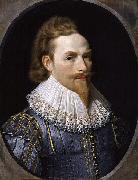 |
Nathaniel Bacon
|
|
(1585-1627) was a wealthy landowner from Culford, Suffolk, England.
self-portraitBacon was an exceptionally skillful amateur painter and gardener. Only a small group of 9 of his paintings survive. He was particularly known for his kitchen and market scenes, dominated by still-life depictions of large vegetables and fruit, often accompanied by a buxom maid, the most well known being "The Cookmaid with Still Life of Vegetables and Fruit" (Tate Gallery London). This predilection for cook or market scenes is much more common among Dutch and Flemish painters, see for example Joachim Beuckelaer (1533-1574), or from a later generation, Pieter Cornelisz van Rijck (1567-ca.1637), and Cornelis Jacobsz Delff.
Bacon is credited with the first known British landscape and also painted a self-portrait and a number of other portraits. He was created a Knight of the Bath in 1625, in honour of the Coronation of Charles I. He died at Culford Hall at the age of 42. He was buried there on 1 July 1627. His little daughter, Jane, aged three years, died that same October and is buried alongside her father. The entries of their burials follow each other in the Culford Parish Burial Register.
He was the son of Sir Nicholas Bacon, 1st Baronet.
|
|
|
|
|
|
 |
Myles Birket Foster,RWS
|
|
1825-1899
English painter, illustrator and collector. After a short and unsatisfactory period working in the family brewing business, he was able to convince his Quaker parents to allow him to pursue a career in art. He was apprenticed to a wood-engraver, Ebenezer Landells (1808-60), who recognized Foster's talent for drawing and set him to work designing blocks for engraving. Foster also provided designs for Punch and the Illustrated London News. In 1846 he set up on his own as an illustrator. The rustic vignettes of the seasons that he contributed to the Illustrated London News and its counterpart, the Illustrated London Almanack, established him as a charming interpreter of the English countryside and rural life and led to his employment illustrating similar themes in other publications. During the 1850s his designs were much in demand; he was called upon to illustrate volumes of the poetry of Longfellow, Sir Walter Scott and John Milton.
|
|
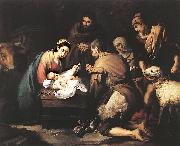 |
MURILLO, Bartolome Esteban
|
|
Spanish Baroque Era Painter, ca.1617-1682
Spanish religious and portrait painter. He was born in Seville, where most of his life was spent. There, c.1645, he painted a series of 11 pictures of the history of the Franciscan order for a monastery. These brought him immediate fame, and for the remainder of his life he was the favorite painter of the wealthy and pious Andalusian capital. His early works show the influence of Zurbarn in the dramatic use of light and shadow. Murillo adapted several compositions from northern and Italian prints. Notable works of his early years include St. Leander, St. Isidore, Vision of St. Anthony (all: cathedral, Seville), Birth of the Virgin (Louvre), and his series for the Church of Santa Maria la Blanca. In 1660 he was instrumental in founding the Seville Academy, of which he shared the presidency with the younger Francisco de Herrera. From 1670 to 1682, Murillo painted many of his major religious works, including those for the Charity Hospital and for the Capuchin convent (Seville Mus.). These religious works, particularly the Madonnas, are noted for their sweetness of mood. In 1682, while working on the Marriage of St. Catherine for the Capuchin church of Cediz, Murillo fell from a scaffold and died as a result of his injuries. Murillo's greatest works include his fine portraits, Don Andres de Andrade y la Col (Metropolitan Mus.) and Knight of the Collar (Prado) and his naturalistic genre paintings, such as Girl and Her Duenna (National Gall., Washington, D.C.) and Peasant Boy (National Gall., London).
|
|
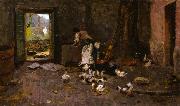 |
Mose Bianchi
|
|
(Monza, 1840-1904) was an Italian painter.
The family moved from Monza to Milan and Bianchi enrolled at the Brera Academy. Having interrupted his studies to serve in the second war of independence, he returned to attend the school of painting directed by Giuseppe Bertini. The award of a grant in 1867 enabled him to visit Venice and then Paris in 1869. He took part with some success at the Brera exhibitions and the Vienna Exhibition of 1873. It was in this period that he began to paint genre scenes in 18th-century settings and numerous portraits, soon becoming one of the artists most in demand with the Milanese middle classes. He returned to Venice in 1879 and visited Chioggia for the first time. Both places were to be featured also in later years in a series of intense views exhibited at exhibitions in Milan and Venice alongside genre scenes, views of Milan and landscapes of the countryside around Gignese.
|
|
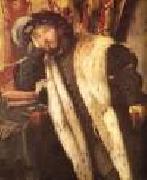 |
MORETTO da Brescia
|
|
Italian High Renaissance Painter, 1498-1554
Italian painter. Together with Romanino and Giovanni Girolamo Savoldo, he was one of the most distinguished painters of Brescia of the 16th century. Influenced by both Lombard verism and contemporary Venetian painters, Moretto created an individual style in which realism and Venetian light and colour were perfectly balanced. He was personally involved in the local movement of Roman Catholic reform, and this is reflected in his direct, solemn and often moving depictions of religious subjects.
|
|
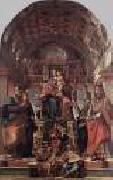 |
MONTAGNA, Bartolomeo
|
|
Italian Early Renaissance Painter, 1450-1523
Painter and draughtsman. Montagna is first documented in 1459 in Vicenza as a minor and, still a minor, in 1467. In 1469 he is recorded as a resident of Venice. In 1474 he was living in Vicenza where, in 1476 and 1478, he was commissioned to paint altarpieces (now lost). He has variously been considered a pupil of Andrea Mantegna (Vasari), Giovanni Bellini, Antonello da Messina, Alvise Vivarini, Domenico Morone and Vittore Carpaccio. While none of these artists, except Carpaccio, was irrelevant to Montagna's stylistic formation, scholars agree that Giovanni Bellini was the primary influence on his art. He may have worked in Bellini's shop around 1470. Several of Montagna's paintings of the Virgin and Child in which the influence of Antonello da Messina is especially marked (e.g. two in Belluno, Mus. Civ.; London, N.G., see Davies, no. 802) are likely to be close in date to Antonello's sojourn in Venice (1475-6); they are therefore best considered Montagna's earliest extant works (Gilbert, 1967) rather than as an unexplained parenthesis around 1485 between two Bellinesque phases (Puppi, 1962). These early paintings appear to be followed by others in which the geometrically rounded forms derived from Antonello become more slender and sharper-edged. Their figures are imbued with a deeply felt, individual humanity, sometimes austere and minatory, sometimes tender. Among them are some larger-scale works, for example the Virgin and Child Enthroned with SS Nicholas and Lucy (Philadelphia, PA, Mus. A.) and a Virgin and Child Enthroned with SS Ansanus, Anthony Abbot, Francis and Jerome
|
|
|
|
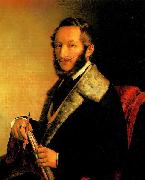 |
Miklos Barabas
|
|
(February 10, 1810 in Mărcuşa, now Romania - February 12, 1898 in Budapest) was a Hungarian painter. He his mostly known for his portrait paintings.
He was born in Kezdimerkosfalva. He spent most of his life in Pest, where he was director of the art society from 1862 until his death. He became a member of the Parliament of Hungary in 1867. He died in Budapest.
|
|
|
|
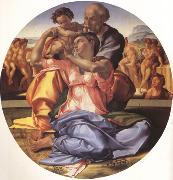 |
Michelangelo Buonarroti
|
|
b Caprese 1475 d Rome 1564
Born: March 6, 1475
Caprese, Italy
Died: February 18, 1564
Rome, Italy
Italian artist
Michelangelo was one of the greatest sculptors of the Italian Renaissance and one of its greatest painters and architects.
Early life
Michelangelo Buonarroti was born on March 6, 1475, in Caprese, Italy, a village where his father, Lodovico Buonarroti, was briefly serving as a Florentine government agent. The family moved back to Florence before Michelangelo was one month old. Michelangelo's mother died when he was six. From his childhood Michelangelo was drawn to the arts, but his father considered this pursuit below the family's social status and tried to discourage him. However, Michelangelo prevailed and was apprenticed (worked to learn a trade) at the age of thirteen to Domenico Ghirlandaio (1449?C1494), the most fashionable painter in Florence at the time.
After a year Michelangelo's apprenticeship was broken off. The boy was given access to the collection of ancient Roman sculpture of the ruler of Florence, Lorenzo de' Medici (1449?C1492). He dined with the family and was looked after by the retired sculptor who was in charge of the collection. This arrangement was quite unusual at the time.
Early works
Michelangelo's earliest sculpture, the Battle of the Centaurs (mythological creatures that are part man and part horse), a stone work created when he was about seventeen, is regarded as remarkable for the simple, solid forms and squarish proportions of the figures, which add intensity to their violent interaction.
Soon after Lorenzo died in 1492, the Medici family fell from power and Michelangelo fled to Bologna. In 1494 he carved three saints for the church of San Domenico. They show dense forms, in contrast to the linear forms which were then dominant in sculpture.
Rome
After returning to Florence briefly, Michelangelo moved to Rome. There he carved a Bacchus for a banker's garden of ancient sculpture. This is Michelangelo's earliest surviving large-scale work, and his only sculpture meant to be viewed from all sides.
In 1498 the same banker commissioned Michelangelo to carve the Piet?? now in St. Peter's. The term piet?? refers to a type of image in which Mary supports the dead Christ across her knees. Larger than life size, the Piet?? contains elements which contrast and reinforce each other: vertical and horizontal, cloth and skin, alive and dead, female and male.
Florence
On Michelangelo's return to Florence in 1501 he was recognized as the most talented sculptor of central Italy. He was commissioned to carve the David for the Florence Cathedral.
Michelangelo's Battle of Cascina was commissioned in 1504; several sketches still exist. The central scene shows a group of muscular soldiers climbing from a river where they had been swimming to answer a military alarm. This fusion of life with colossal grandeur henceforth was the special quality of Michelangelo's art.
From this time on, Michelangelo's work consisted mainly of very large projects that he never finished. He was unable to turn down the vast commissions of his great clients which appealed to his preference for the grand scale.
Pope Julius II (1443?C1513) called Michelangelo to Rome in 1505 to design his tomb, which was to include about forty life-size statues. Michelangelo worked on the project off and on for the next forty years.
Sistine Chapel
In 1508 Pope Julius II commissioned Michelangelo to decorate the ceiling of the chief Vatican chapel, the Sistine. The traditional format of ceiling painting contained only single figures. Michelangelo introduced dramatic scenes and an original framing system, which was his earliest architectural design. The chief elements are twelve male and female prophets (the latter known as sibyls) and nine stories from Genesis.
Michelangelo stopped for some months halfway along. When he returned to the ceiling, his style underwent a shift toward a more forceful grandeur and a richer emotional tension than in any previous work. The images of the Separation of Light and Darkness, and Ezekiel illustrate this greater freedom and mobility.
After the ceiling was completed in 1512, Michelangelo returned to the tomb of Julius and carved a Moses and two Slaves. His models were the same physical types he used for the prophets and their attendants in the Sistine ceiling. Julius's death in 1513 halted the work on his tomb.
Pope Leo X, son of Lorenzo de' Medici, proposed a marble facade for the family parish church of San Lorenzo in Florence to be decorated with statues by Michelangelo. After four years of quarrying and designing the project was canceled.
Medici Chapel
In 1520 Michelangelo was commissioned to execute the Medici Chapel for two young Medici dukes. It contains two tombs, each with an image of the deceased and two allegorical (symbolic) figures: Day and Night on one tomb, and Morning and Evening on the other.
A library, the Biblioteca Laurenziana, was built at the same time on the opposite side of San Lorenzo to house Pope Leo X's books. The entrance hall and staircase are some of Michelangelo's most astonishing architecture, with recessed columns resting on scroll brackets set halfway up the wall and corners stretched open rather than sealed.
Poetry
Michelangelo wrote many poems in the 1530s and 1540s. Approximately three hundred survive. The earlier poems are on the theme of Neoplatonic love (belief that the soul comes from a single undivided source to which it can unite again) and are full of logical contradictions and intricate images. The later poems are Christian. Their mood is penitent (being sorrow and regretful); and they are written in a simple, direct style.
Last Judgment
In 1534 Michelangelo left Florence for the last time, settling in Rome. The next ten years were mainly given over to painting for Pope Paul III (1468?C1549).
|
|
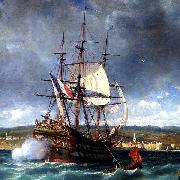 |
Michel Bouquet
|
|
(born 6 November 1925) is a French film actor. He has appeared in over 90 films since 1947. He was born in Paris, France.
|
|
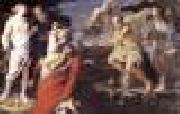 |
MEI, Bernardino
|
|
Italian painter, Roman school (b. 1612, Siena, d. 1676, Roma)
Italian painter, draughtsman and printmaker. His early art drew on a variety of sources, which included the naturalism of Rutilio Manetti and Francesco Rustici, the descriptive realism of the engraver Giuliano Periccioli (d 1646) and the Baroque of Raffaelle Vanni. Mei's interests even embraced 16th-century Sienese art. This stylistic variety is evident in his first known works, such as a bier (Casole d'Elsa, Collegiata), three signed miniatures in the Libro dei leoni (1634; Siena, Pal. Piccolomini, Archv Stato) and frescoes of scenes from the Life of St Bernard (1639; Siena, oratory of S Bernardino). His experimental approach is also displayed in such works as the Annunciation (Siena, Mus. Semin. Montarioso), which may be dated between the mid-1630s and the early 1640s. Mei's early maturity is marked by a conscious return to the naturalism of Manetti, enriched with a Baroque pathos and soft, fluid brushwork, as in the St Peter in Prison Awoken by the Angel and St Peter Freed by the Angel (both Siena; Conservatori Femminili Riuniti). His interest in both naturalism and the Baroque made him responsive to the art of Mattia Preti, possibly seen in Rome, as in the Beheading of St John the Baptist (1647; Siena, oratory of S Giovannino in Pantaneto) and the frescoes of scenes from the Life of St Roch and Life of St Job (1648; Siena, S Rocco),
|
|
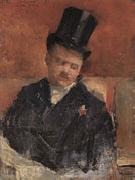 |
Max Buri
|
|
1868-1915,Swiss painter. While still at school he was given drawing lessons by Paul Volmar (1832-1906) in Berne. From 1883 he was a pupil of Fritz Schider (1846-1907) in Basle, where he became acquainted with the works of Hans Holbein the younger and Arnold B?cklin. In 1886 he went to the Akademie der Bildenden K?nste in Munich, transferring in 1887 to Simon Holl?sy painting school. After seeing the works of the French Impressionists exhibited in Munich, he moved to the Acad?mie Julian in Paris in 1889. He made several journeys to Algeria, Holland, Belgium and England, and in 1893 he returned to Munich to study under Albert von Keller. In 1898 he settled in Switzerland, living first at Lucerne, then from 1903 in Brienz, near Interlaken. About 1900, influenced by the paintings of Ferdinand Hodler, Buri moved on from his early genre pictures, which were in mawkish shades of pink in the style of Keller and H?llosy, to achieve an individual style that brought him great popularity. He established his reputation with Village Politicians (1904; Basle, Kstmus.). He painted mainly the landscape and people of the Bernese Oberland, often depicting single figures and groups in front of bare indoor walls in realistic everyday scenes. The expressiveness of the compositions is achieved by clear contours and powerful clearly differentiated surfaces in local colours. Buri works are essentially populist rather than intellectual and avoid Hodler strict parallelism and Symbolist content.
|
|
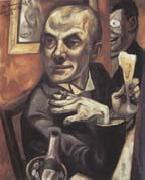 |
Max Beckmann
|
|
1884-1950
was a German painter, draftsman, printmaker, sculptor, and writer. Although he is usually classified as an Expressionist artist, he rejected both the term and the movement. In the 1920s he was associated with the New Objectivity (Neue Sachlichkeit), an outgrowth of Expressionism that opposed its introverted emotionalism. He was born into a middle-class family in Leipzig, Saxony. From his youth he pitted himself against the old masters. His traumatic experiences of World War I, in which he served as a medic, coincided with a dramatic transformation of his style from academically correct depictions to a distortion of both figure and space, reflecting his altered vision of himself and humanity.He is known for the self-portraits he painted throughout his life, their number and intensity rivalled only by Rembrandt and Picasso. Well-read in philosophy and literature, he also contemplated mysticism and theosophy in search of the "Self". As a true painter-thinker, he strove to find the hidden spiritual dimension in his subjects. (Beckmann's 1948 "Letters to a Woman Painter" provides a statement of his approach to art.) In the Weimar Republic of the Twenties, Beckmann enjoyed great success and official honors. In 1927 he received the Honorary Empire Prize for German Art and the Gold Medal of the City of D??sseldorf; the National Gallery in Berlin acquired his painting The Bark and, in 1928, purchased his Self-Portrait in Tuxedo.In 1925 he was selected to teach a master class at the Städelschule Academy of Fine Art in Frankfurt. Some of his most famous students included Theo Garve, Leo Maillet and Marie-Louise Von Motesiczky. His fortunes changed with the rise to power of Adolf Hitler, whose dislike of Modern Art quickly led to its suppression by the state. In 1933, the Nazi government bizarrely called Beckmann a "cultural Bolshevik"and dismissed him from his teaching position at the Art School in Frankfurt. In 1937 more than 500 of his works were confiscated from German museums, and several of these works were put on display in the notorious Degenerate Art exhibition in Munich.For ten years, Beckmann lived in poverty in self-imposed exile in Amsterdam, failing in his desperate attempts to obtain a visa for the US. In 1944 the Germans attempted to draft him into the army, despite the fact that the sixty-year-old artist had suffered a heart attack. The works completed in his Amsterdam studio were even more powerful and intense than the ones of his master years in Frankfurt, and included several large triptychs, which stand as a summation of Beckmann's art. After the war, Beckmann moved to the United States, and during the last three years of his life, he taught at the art schools of Washington University in St. Louis (with the German-American painter and printmaker Werner Drewes) and the Brooklyn Museum. He suffered from angina pectoris and died after Christmas 1950, struck down by a heart attack in Manhattan.Many of his late paintings are now displayed in American museums.
|
|
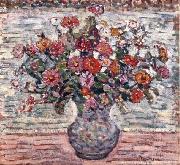 |
Maurice Brazil Prendergast
|
|
(October 10, 1858 - February 1, 1924) was a U.S. Post-Impressionist artist who worked in oil, watercolor, and monotype. Technically, he was a member of The Eight, but the delicacy of his compositions and mosaic-like beauty of his designs had little in common with the philosophy of the group.
Prendergast was born in St. John's, a city in Newfoundland, Canada. With the failure of his father's subarctic trading post, the family moved to Boston.
|
|
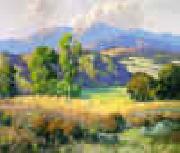 |
Maurice Braun
|
|
1877-1941
Maurice Braun (1877-1941) was an American artist who became known for wonderful Impressionist landscapes of southern California. He was born in Hungary on October 1, 1877, however by the age of four young Maurice and the Braun family had migrated to the United States and settled in New York City. His professional studies took him to the National Academy of Fine Arts where he studied the French tradition under Francis C. Jones, George W. Maynard and Edgar M. Ward. In 1901 Braun trained under the famous American painter William Merritt Chase (1849-1916). He established himself as a figure and portrait painter in New York City, but in 1909 he left for California where he was inspired and reveled in the new colors, forms, light and atmosphere of the region -- his paintings reflect a deep respect and appreciation for nature. Maurice Braun died in San Diego, California on November 7, 1941.
|
|
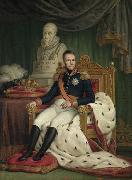 |
Mattheus Ignatius van Bree
|
|
was a Belgian painter, sculptor and architect.
He was born at Antwerp in 1773, was instructed by Regemorter; he afterwards went to Paris, and after having obtained by a 'Cato in Utica' the second prize for Rome, he went to that city in 1797e returning to his native country in 1804.[1] He painted numerous historical pictures, some of which are of large dimensions, and obtained a high reputation in Flanders. His conceptions are frequently poetical, and his compositions graceful, delineated with a light, free, and spirited pencil ; but his colouring is rather too florid in some instances.
He was first professor at the Academy of Fine Arts at Antwerp, and in 1827 its director. Member of several other scientific institutions like the academies of Amsterdam, Rome, Munich and New York. Among his most important works are 'The Patriotism of the Burgomaster Van der Werft,' in the Town-Hall at Leyden, and 'The Death of Rubens,' in the Museum at Antwerp. He brought forward some of the most eminent of the later Flemish painters, among whom are Wappers, De Keyser, F. de Braekeleer, and others of whom their country is justly proud. Van Bree died at Antwerp in 1839.
|
|
|
|
|
|
|
|
|
| Wholesale China Oil Painting Wholesale Oil Painting China Xiamen Portrait Reproduction on canvas Chinese Oil Painting Wholesale USA Oil Painting |
|
|
|
|
|